Spectral Simulation and Error Analysis of Dusty Leaves by Fusing the Hapke Two-Layer Medium Model and the Linear Spectral Mixing Model
Abstract
:1. Introduction
2. Data, Methods, and Method Optimization
2.1. Data (Measured Spectral Data)
2.2. Theoretical Basis
2.2.1. Physical Thickness and Optical Thickness
2.2.2. The Hapke Two-Layer Medium Model
2.3. The Fusion of the Hapke Two-Layer Medium Model and the Linear Spectral Mixing Model
2.3.1. Arrangement and Accumulation of Dust Particles
- When the accumulation of dust particles is less than one layer, the calculation process for the equivalent physical thickness is as follows:
- 2.
- When the accumulation layer of dust particles is one layer, there are two parts to calculating the equivalent physical thickness of the dust medium.
- < (
- ( < < (
2.3.2. The Dust Coverage Factor
3. Results
3.1. Measured Spectra and Simulated Spectra by Using Hapke Two-Layer Medium Model Directly
3.2. Results Based on the Fused Model
4. Discussion
4.1. The Effect of Particle Accumulation on the Filling Factor and the Simulated Spectrum
4.2. Calculation and Comparison of the Dust Coverage Factor
4.3. The Influence of Different Correction Formulas on Error Correction
5. Conclusions
Author Contributions
Funding
Institutional Review Board Statement
Informed Consent Statement
Data Availability Statement
Acknowledgments
Conflicts of Interest
References
- Yan, X.; Shi, W.; Zhao, W.; Luo, N. Mapping dustfall distribution in urban areas using remote sensing and ground spectral data. Sci. Total Environ. 2015, 506, 604–612. [Google Scholar] [CrossRef] [PubMed]
- Xu, L.; Mu, G.; Ren, X.; Sun, L.; Lin, Y.; Wan, D. Spatial distribution of dust deposition during dust storms in Cele Oas is, on the southern margin of the Tarim Basin. Arid. Land Res. Manag. 2016, 30, 25–36. [Google Scholar] [CrossRef]
- Bali, K.; Mishra, A.K.; Singh, S.; Chandra, S.; Lehahn, Y. Impact of dust storm on phytoplankton bloom over the Arabian Sea: A case study during March 2012. Env. Sci. Pollut. Res. 2019, 26, 11940–11950. [Google Scholar] [CrossRef] [PubMed]
- Payne, R.J.; Symeonakis, E. The spatial extent of tephra deposition and environmental impacts from the 1912 Novarupta eruption. Bull. Volcanol. 2012, 74, 2449–2458. [Google Scholar] [CrossRef]
- Qi, J.; Nadhir, A.A.; Knutsson, S. Dust Generation within the Vicinity of Malmberget Mine, Sweden. AMM 2011, 90, 752–759. [Google Scholar] [CrossRef]
- Lamare, R.E.; Singh, O.P. Effect of cement dust on soil physico-chemical properties around cement plants in Jaintia Hills, Meghalaya. Environ. Eng. Res. 2019, 25, 409–417. [Google Scholar] [CrossRef]
- Deng, Q.; Deng, L.; Miao, Y.; Guo, X.; Li, Y. Particle deposition in the human lung: Health implications of particulate matter from different sources. Environ. Res. 2019, 169, 237–245. [Google Scholar] [CrossRef]
- Hariram, M.; Sahu, R.; Elumalai, S.P. Impact Assessment of Atmospheric Dust on Foliage Pigments and Pollution Resistances of Plants Grown Nearby Coal Based Thermal Power Plants. Arch. Environ. Contam. Toxicol. 2017, 74, 56–70. [Google Scholar] [CrossRef]
- Navrátil, T.; Hladil, J.; Strnad, L.; Koptíková, L.; Skála, R. Volcanic ash particulate matter from the 2010 Eyjafjallajökull eruption in dust deposition at Prague, central Europe. Aeolian Res. 2013, 9, 191–202. [Google Scholar] [CrossRef]
- Mandal, K.; Kumar, A.; Tripathi, N.; Singh, R.S.; Chaulya, S.K.; Mishra, P.K.; Bandyopadhyay, L.K.; Council of Scientific and Industrial Research. Characterization of different road dusts in opencast coal mining areas of India. Environ. Monit. Assess 2011, 184, 3427–3441. [Google Scholar] [CrossRef]
- Gil-Loaiza, J.; Field, J.P.; White, S.A.; Csavina, J.; Felix, O.; Betterton, E.A.; Sáez, A.E.; Maier, R.M. Phytoremediation Reduces Dust Emissions from Metal(loid)-Contaminated Mine Tailings. Environ. Sci. Technol. 2018, 52, 5851–5858. [Google Scholar] [CrossRef]
- Tian, S.; Liang, T.; Li, K. Fine road dust contamination in a mining area presents a likely air pollution hotspot and threat to human health. Environ. Int. 2019, 128, 201–209. [Google Scholar] [CrossRef]
- Adhikari, S.; Jordaan, A.; Beukes, J.P.; Siebert, S.J. Anthropogenic Sources Dominate Foliar Chromium Dust Deposition in a Mi ning-Based Urban Region of South Africa. Int. J. Env. Res. Public Health 2022, 19, 2072. [Google Scholar] [CrossRef]
- Liu, Y.; Wu, J.; Yu, D.; Ma, Q. The relationship between urban form and air pollution depends on seasonality and city size. Env. Sci. Pollut. Res. Int. 2018, 25, 15554–15567. [Google Scholar] [CrossRef]
- Lu, Y.; Wang, Y.; Zuo, J.; Jiang, H.; Huang, D.; Rameezdeen, R. Characteristics of public concern on haze in China and its relationship with air quality in urban areas. Sci. Total Environ. 2018, 637, 1597–1606. [Google Scholar] [CrossRef]
- Von Schneidemesser, E.; Steinmar, K.; Weatherhead, E.C.; Bonn, B.; Gerwig, H.; Quedenau, J. Air pollution at human scales in an urban environment: Impact of local environment and vehicles on particle number concentrations. Sci. Total Environ. 2019, 688, 691–700. [Google Scholar] [CrossRef]
- Chaudhary, I.J.; Rathore, D. Dust pollution: Its removal and effect on foliage physiology of urban trees. Sustain. Cities Soc. 2019, 51, 101696. [Google Scholar] [CrossRef]
- Javanmard, Z.; Kouchaksaraei, M.T.; Hosseini, S.M.; Pandey, A.K. Assessment of anticipated performance index of some deciduous plant species under dust air pollution. Env. Sci. Pollut. Res. 2020, 27, 38987–38994. [Google Scholar] [CrossRef]
- Sun, H.; Li, A.; Wu, J. Entrained air by particle plume: Comparison between theoretical derivation and numerical analysis. Part. Sci. Technol. 2019, 39, 141–149. [Google Scholar] [CrossRef]
- Cleaver, A.E.; White, H.P.; Rickwood, C.J.; Jamieson, H.E.; Huntsman, P. Field comparison of fugitive tailings dust sampling and monitoring methods. Sci. Total Environ. 2022, 823, 153409. [Google Scholar] [CrossRef]
- Watkinson, A.D.; Virgl, J.; Miller, V.S.; Naeth, M.A.; Kim, J.; Serben, K.; Shapka, C.; Sinclair, S. Effects of dust deposition from diamond mining on subarctic plant communities and barren-ground caribou forage. J. Environ. Qual. 2021, 50, 990–1003. [Google Scholar] [CrossRef] [PubMed]
- Lin, W.; Li, Y.; Du, S.; Zheng, Y.; Gao, J.; Sun, T. Effect of dust deposition on spectrum-based estimation of leaf water content in urban plant. Ecol. Indic. 2019, 104, 41–47. [Google Scholar] [CrossRef]
- Zhu, J.; Yu, Q.; Zhu, H.; He, W.; Xu, C.; Liao, J.; Zhu, Q.; Su, K. Response of dust particle pollution and construction of a leaf dust deposition prediction model based on leaf reflection spectrum characteristics. Environ. Sci. Pollut. Res. Int. 2019, 26, 36764–36775. [Google Scholar] [CrossRef]
- Zhu, J.; Xu, J.; Cao, Y.; Fu, J.; Li, B.; Sun, G.; Zhang, X.; Xu, C. Leaf reflectance and functional traits as environmental indicators of urban dust deposition. BMC Plant Biol. 2021, 21, 533. [Google Scholar] [CrossRef] [PubMed]
- Zhang, X.-X.; Sharratt, B.; Lei, J.-Q.; Wu, C.-L.; Zhang, J.; Zhao, C.; Wang, Z.-F.; Wu, S.-X.; Li, S.-Y.; Liu, L.-Y.; et al. Parameterization schemes on dust deposition in northwest China: Model validation and implications for the global dust cycle. Atmos. Environ. 2019, 209, 1–13. [Google Scholar] [CrossRef]
- Dadashi-Roudbari, A.; Ahmadi, M.; Shakiba, A. Seasonal study of dust deposition and fine particles (PM 2.5) in Iran using MERRA-2 data. Iran. J. Geophys. 2020, 13, 43–59. [Google Scholar] [CrossRef]
- Kallel, A.; Verhoef, W.; Le Hegarat-Mascle, S.; Ottle, C.; Hubert-Moy, L. Canopy bidirectional reflectance calculation based on Adding method and SAIL formalism: AddingS/AddingSD. Remote Sens. Environ. 2008, 112, 3639–3655. [Google Scholar] [CrossRef]
- Zhai, L.; Wan, L.; Sun, D.; Abdalla, A.; Zhu, Y.; Li, X.; He, Y.; Cen, H. Stability evaluation of the PROSPECT model for leaf chlorophyll content retrieval. Int. J. Agric. Biol. Eng. 2021, 14, 189–198. [Google Scholar] [CrossRef]
- Jacquemoud, S.; Verhoef, W.; Baret, F.; Bacour, C.; Zarco-Tejada, P.J.; Asner, G.P.; François, C.; Ustin, S.L. PROSPECT+SAIL models: A review of use for vegetation characterization. Remote Sens. Environ. 2009, 113, S56–S66. [Google Scholar] [CrossRef]
- Jacquemoud, S.; Verhoef, W.; Baret, F.; Zarco-Tejada, P.J.; Asner, G.P.; Francois, C.; Ustin, S.L. PROSPECT+SAIL: 15 Years of Use for Land Surface Characterization. In Proceedings of the IEEE International Geoscience and Remote Sensing Symposium (IGARSS), Denver, CO, USA, 31 July–4 August 2006; p. 1992. [Google Scholar]
- Wang, Y.; Gastellu-Etchegorry, J.-P. Accurate and fast simulation of remote sensing images at top of atmosphere with DART-Lux. Remote Sens. Environ. 2021, 256, 112311. [Google Scholar] [CrossRef]
- Gastellu-Etchegorry, J.P.; Martin, E.; Gascon, F.; Belot, A.; Lefevre, M.J.; Boyat, P.; Gentine, P.; Ader, G.; Deschard, J.; Torruella, P.; et al. DART: 3-D model of optical satellite images and radiation budget. In Proceedings of the IEEE International Symposium on Geoscience and Remote Sensing (IGARSS), Toulouse, France, 21–25 July 2003; IEEE: Piscataway, NJ, USA, 2003; pp. 3242–3244. [Google Scholar]
- Hapke, B. Bidirectional reflectance spectroscopy: 1. Theory. J. Geophys. Res. 1981, 86, 3039–3054. [Google Scholar] [CrossRef] [Green Version]
- Hapke, B. Theory of Reflectance and Emittance Spectroscopy, 2nd ed.; Cambridge University Press: Cambridge, UK, 2012. [Google Scholar]
- Ding, A.; Ma, H.; Liang, S.; He, T. Extension of the Hapke model to the spectral domain to characterize soil physical properties. Remote Sens. Environ. 2022, 269, 112843. [Google Scholar] [CrossRef]
- Johnson, J.R.; Grundy, W.M.; Lemmon, M.T. Dust deposition at the Mars Pathfinder landing site: Observations and modeling of visible/near-infrared spectra. Icarus 2003, 163, 330–346. [Google Scholar] [CrossRef]
- Al-Hasan, A.Y. A new correlation for direct beam solar radiation received by photovoltaic panel with sand dust accumulated on its surface. Sol. Energy 1998, 63, 323–333. [Google Scholar] [CrossRef]
- Beattie, N.S.; Moir, R.S.; Chacko, C.; Buffoni, G.; Roberts, S.H.; Pearsall, N.M. Understanding the effects of sand and dust accumulation on photovoltaic modules. Renew. Energy 2012, 48, 448–452. [Google Scholar] [CrossRef] [Green Version]
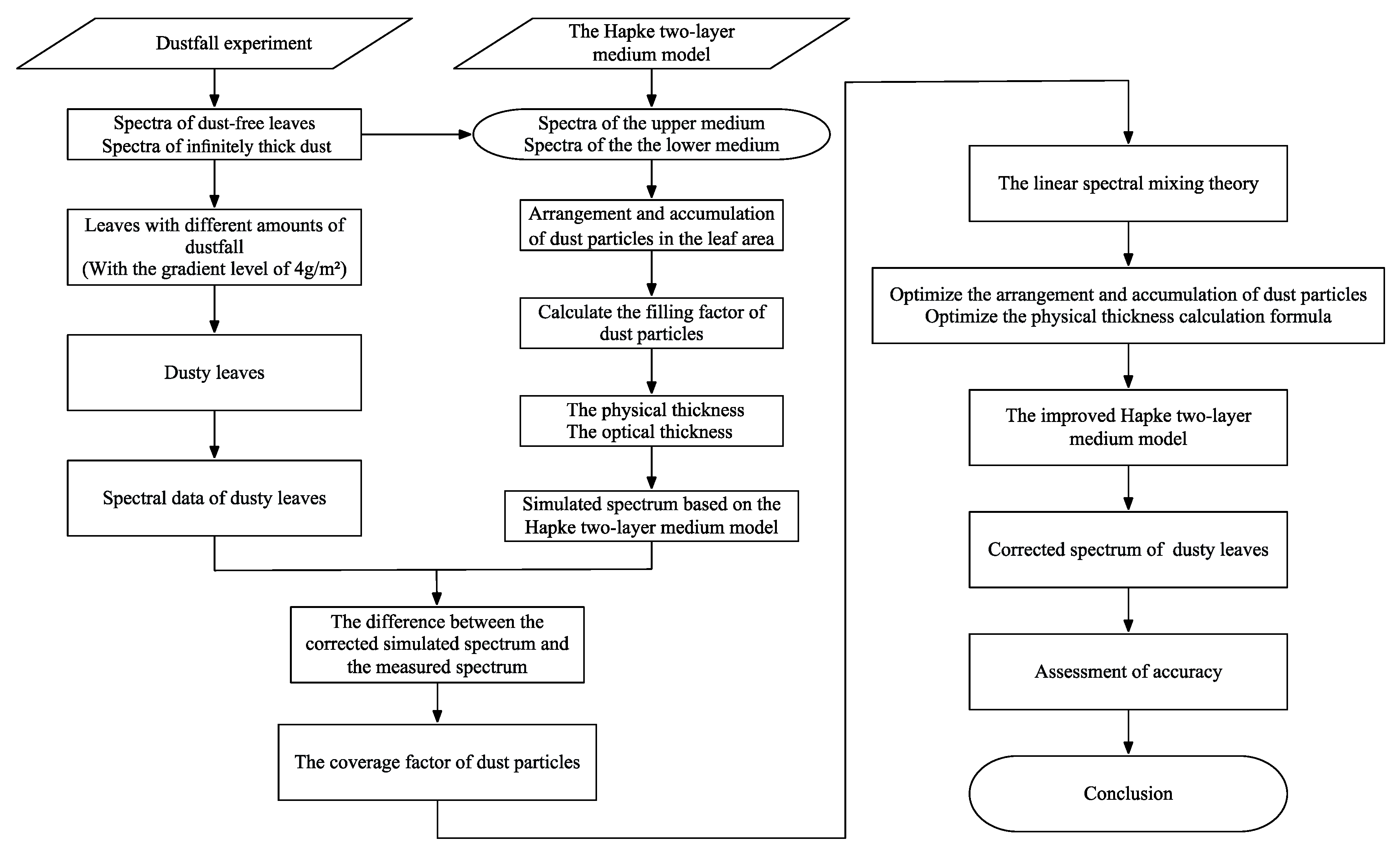
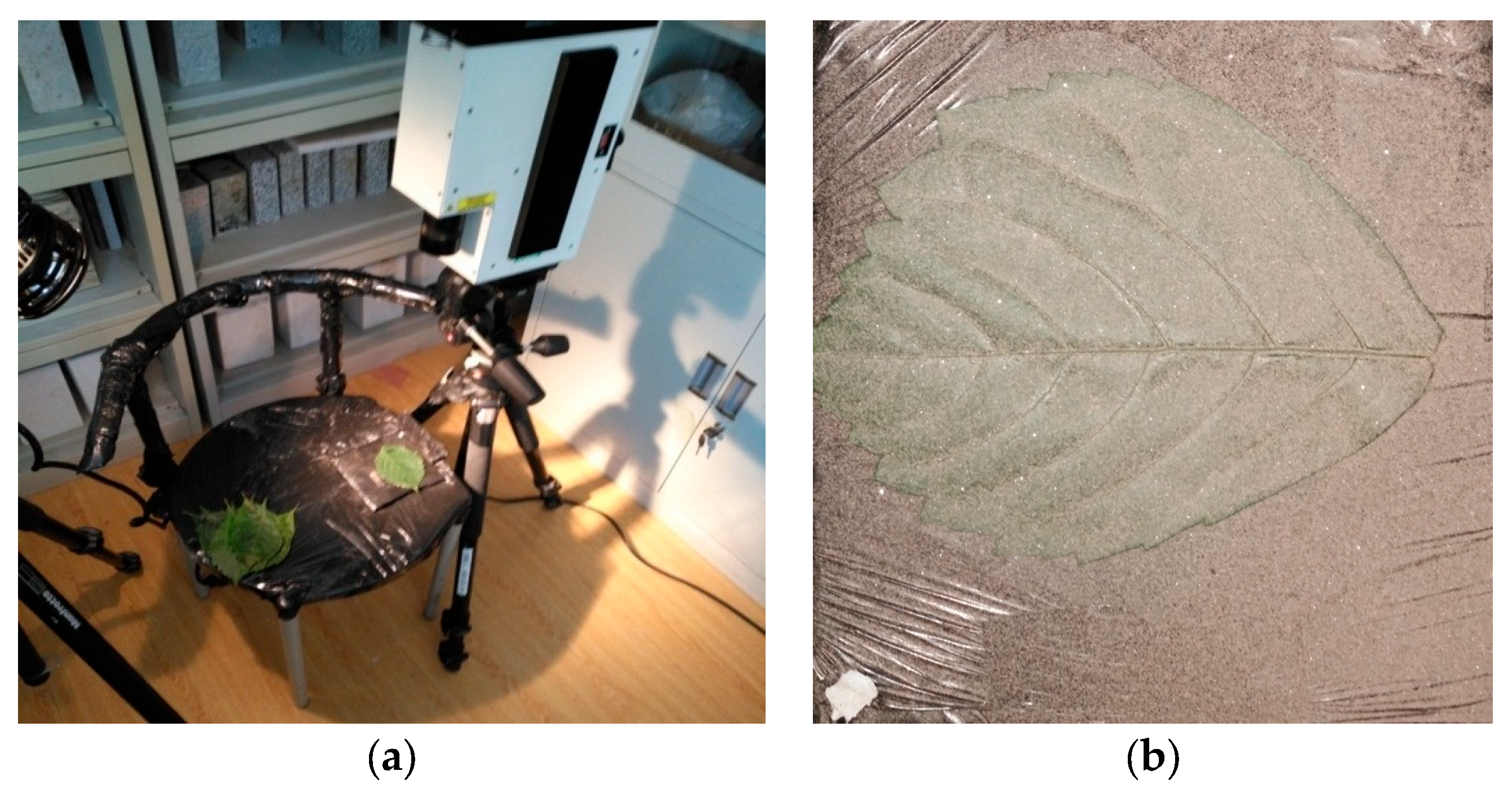
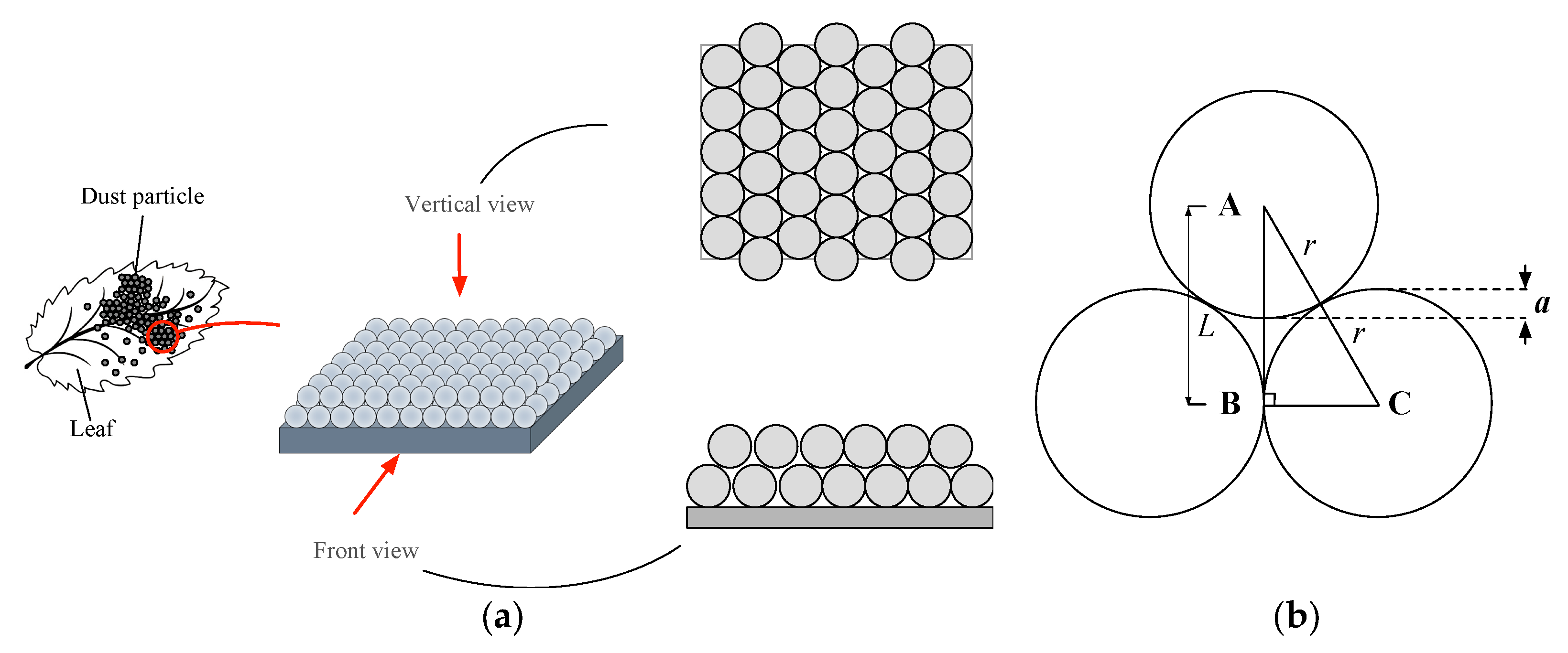
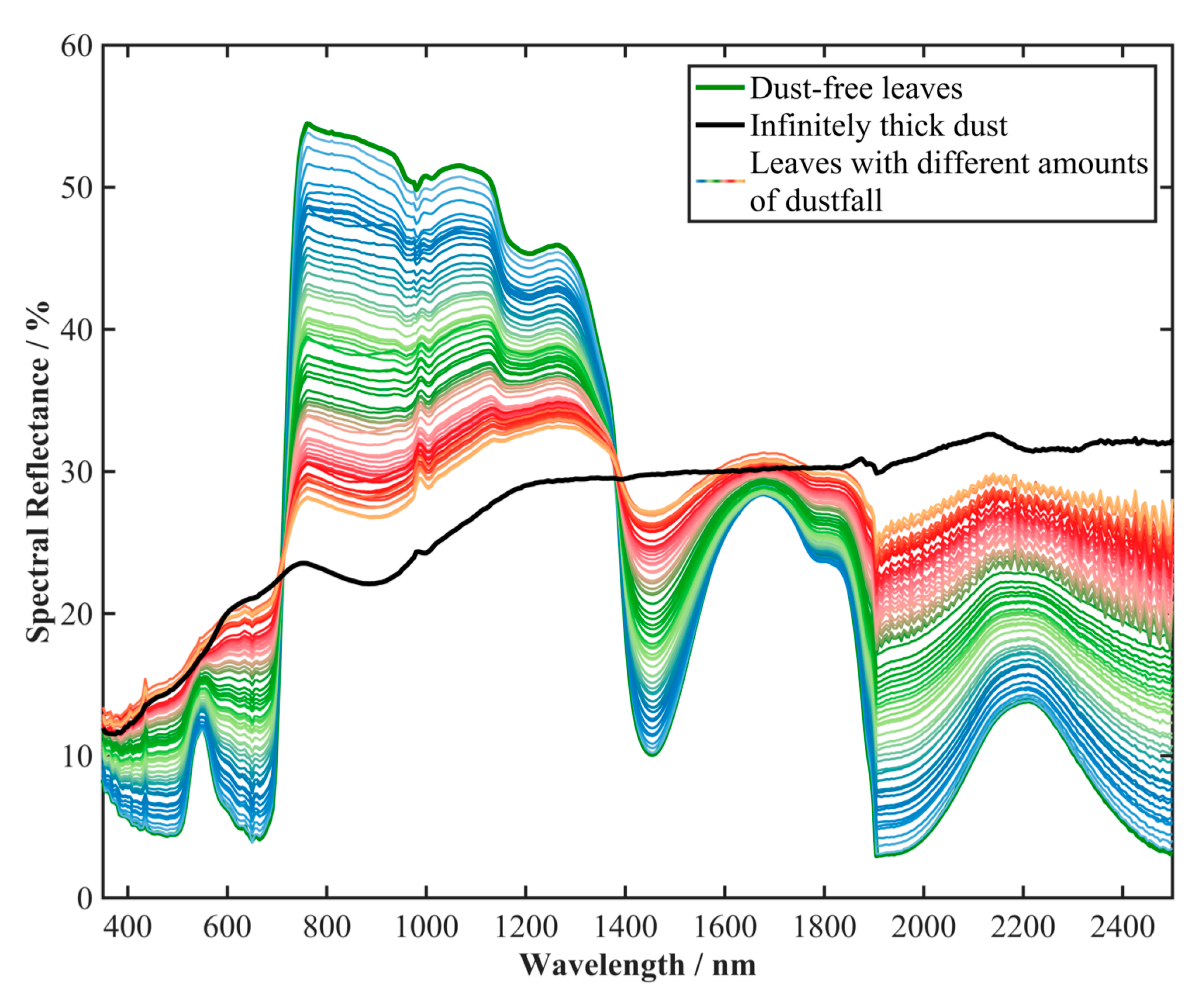
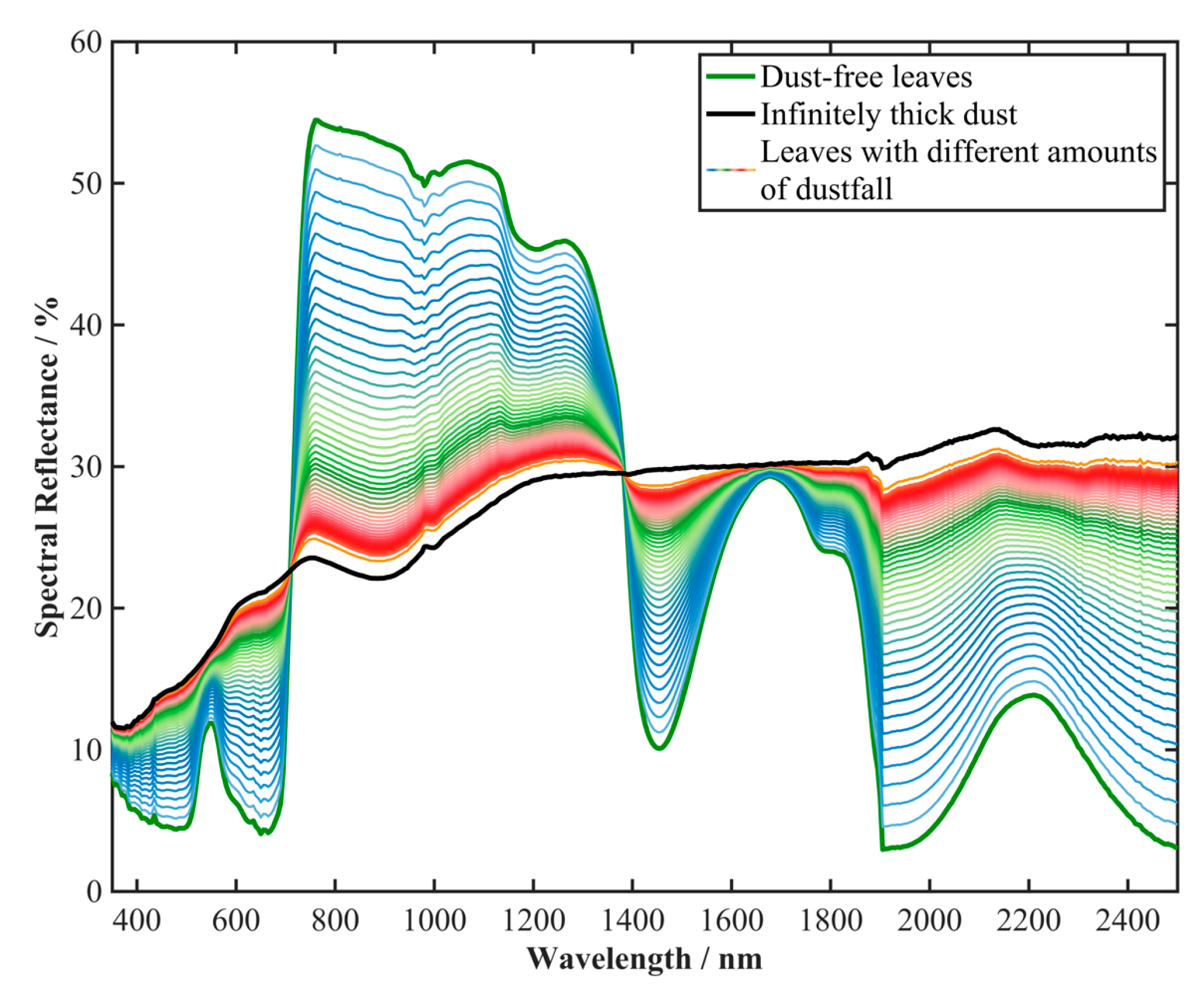
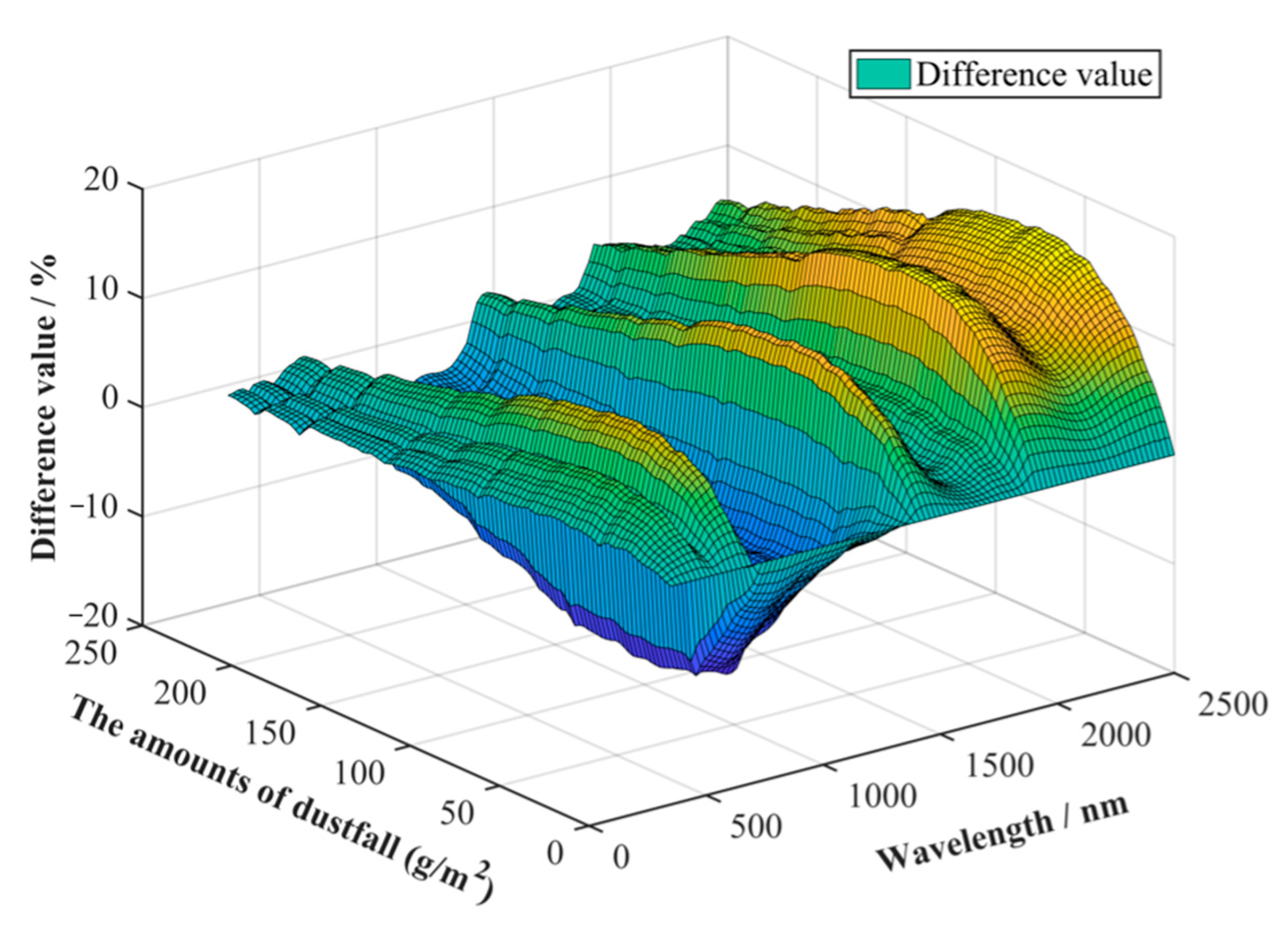

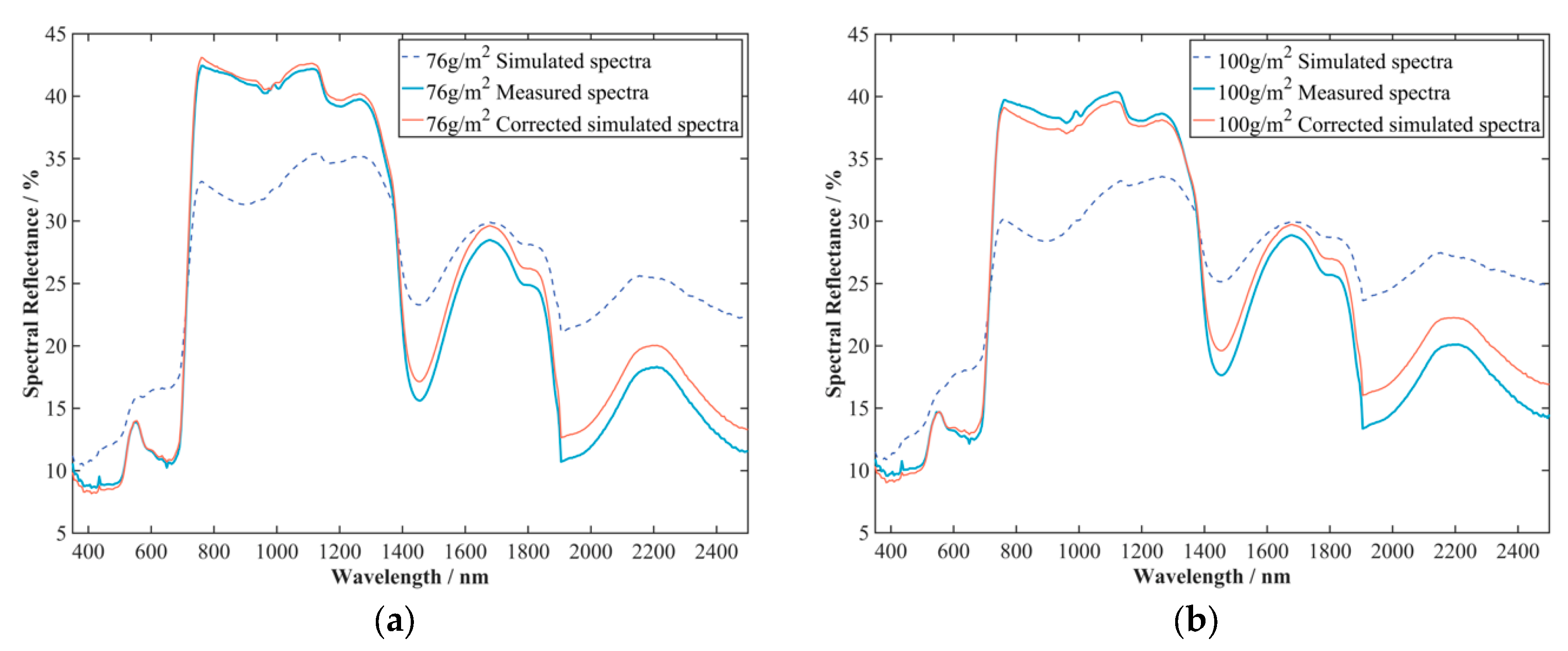
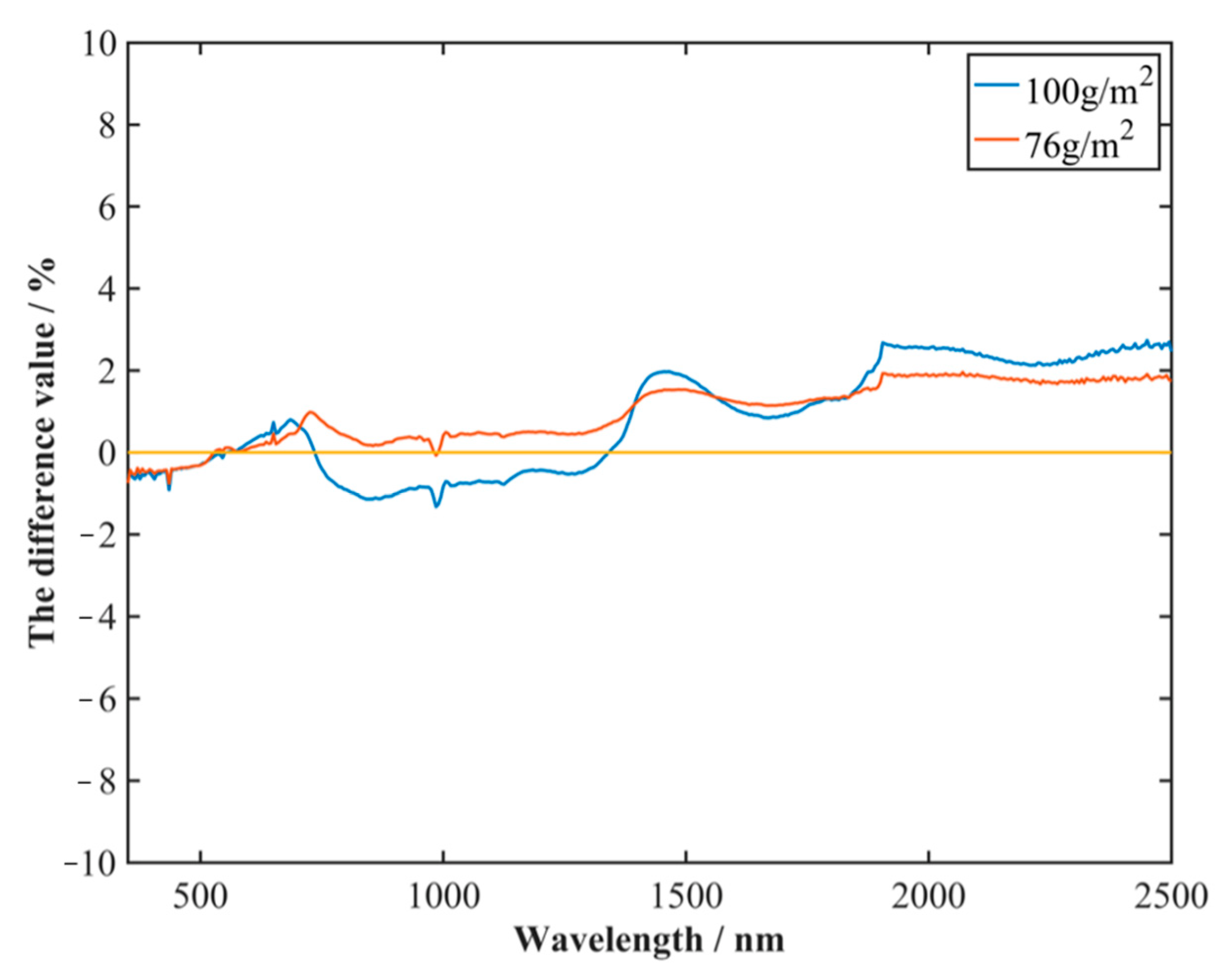
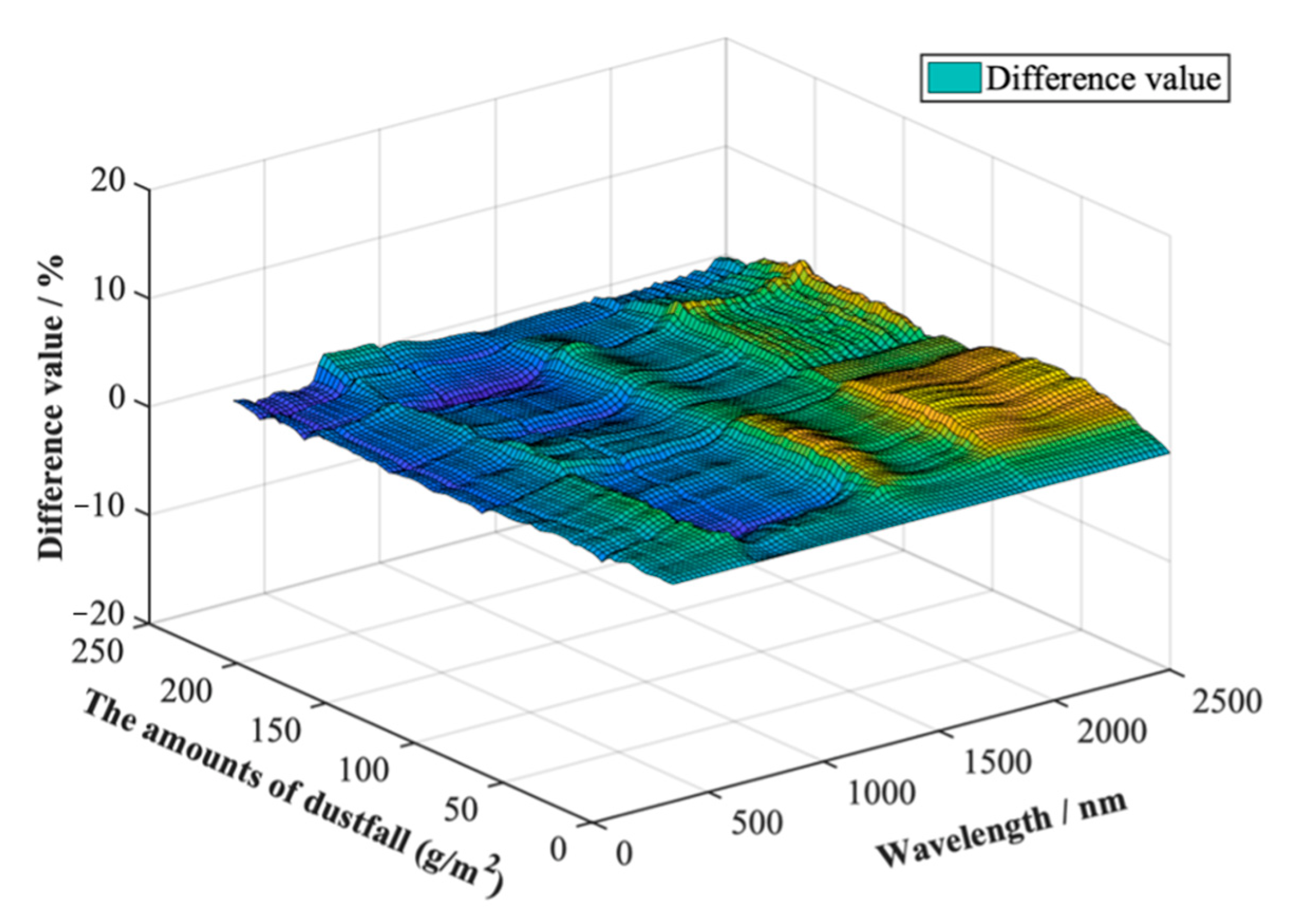
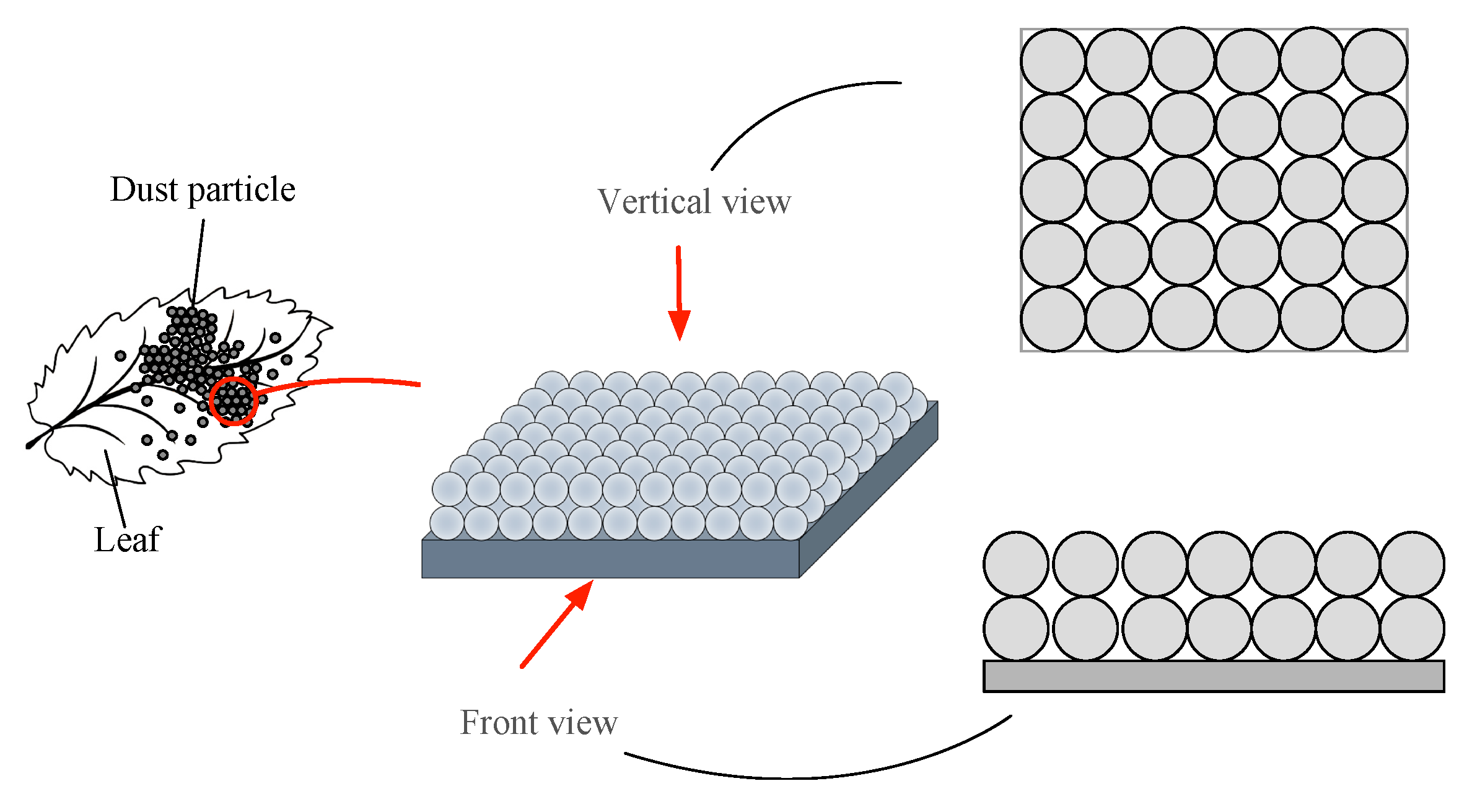

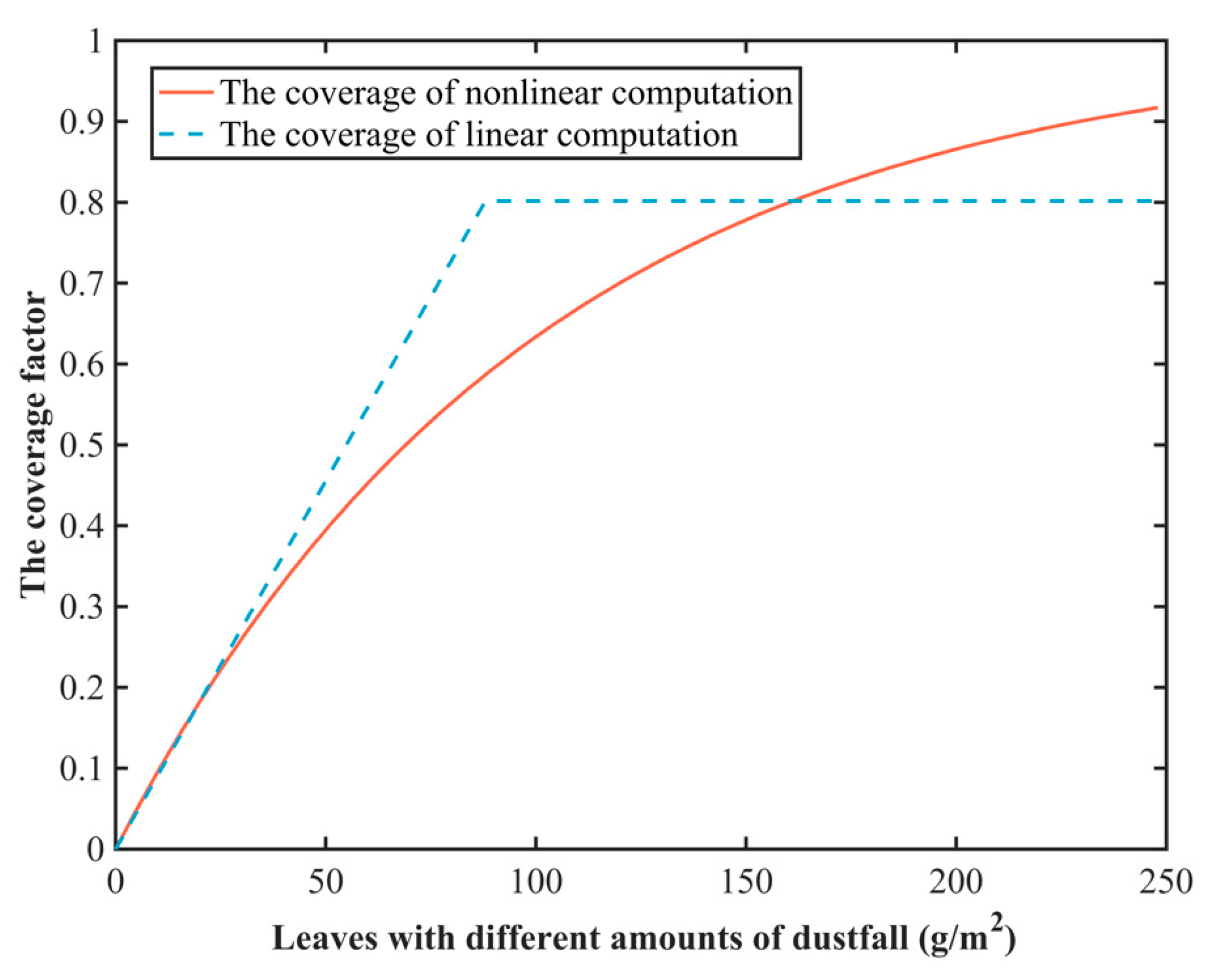

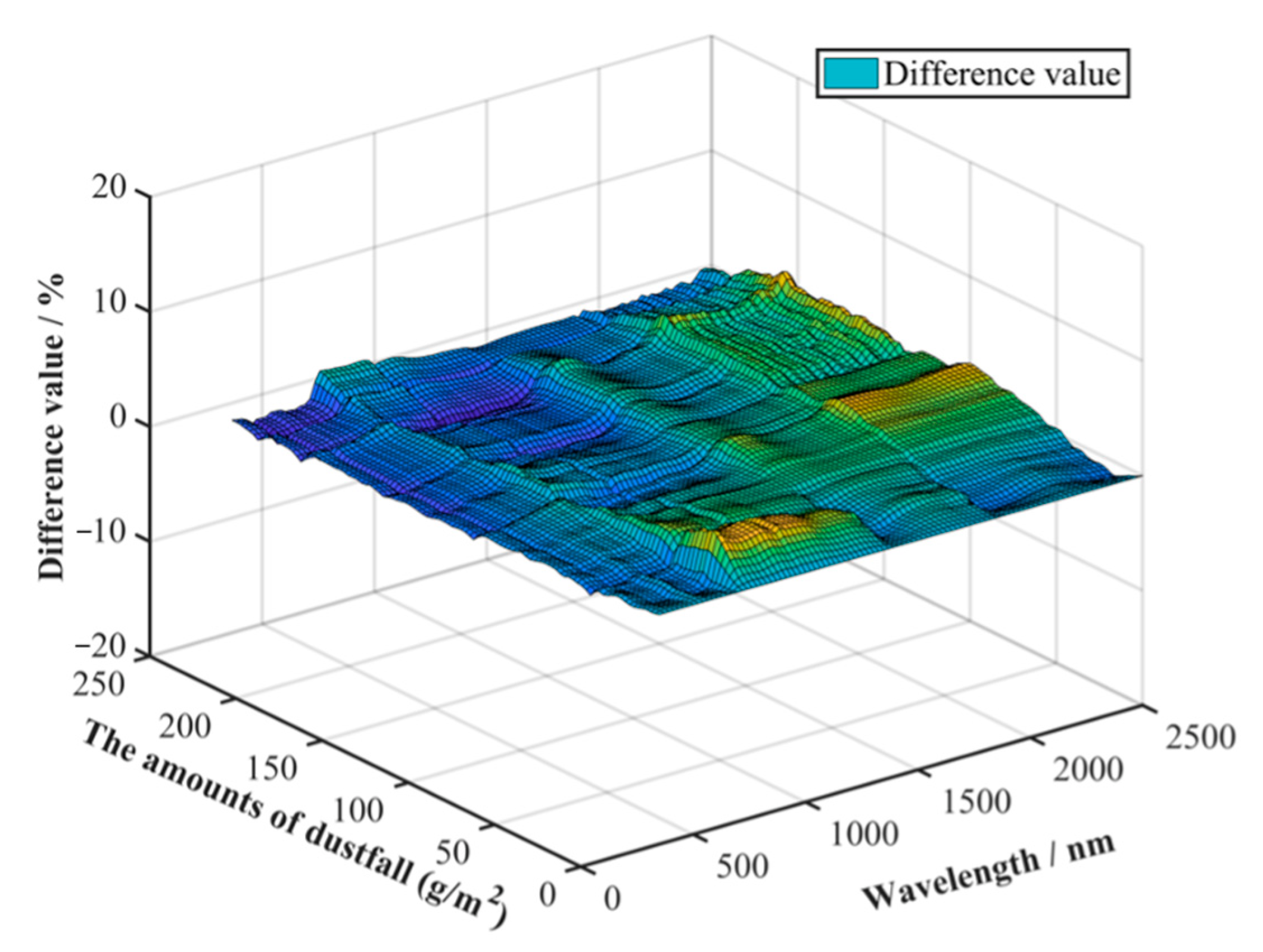
| Composition | SiO2 | TFe | FeO | MgO | Al2O3 | CaO |
|---|---|---|---|---|---|---|
| Content (%) | 82.28 | 9.90 | 1.62 | 0.85 | 0.73 | 0.66 |
Disclaimer/Publisher’s Note: The statements, opinions and data contained in all publications are solely those of the individual author(s) and contributor(s) and not of MDPI and/or the editor(s). MDPI and/or the editor(s) disclaim responsibility for any injury to people or property resulting from any ideas, methods, instructions or products referred to in the content. |
© 2023 by the authors. Licensee MDPI, Basel, Switzerland. This article is an open access article distributed under the terms and conditions of the Creative Commons Attribution (CC BY) license (https://creativecommons.org/licenses/by/4.0/).
Share and Cite
Ma, B.; Yang, X.; Che, D.; Shu, Y.; Liu, Q.; Su, M. Spectral Simulation and Error Analysis of Dusty Leaves by Fusing the Hapke Two-Layer Medium Model and the Linear Spectral Mixing Model. Remote Sens. 2023, 15, 1220. https://doi.org/10.3390/rs15051220
Ma B, Yang X, Che D, Shu Y, Liu Q, Su M. Spectral Simulation and Error Analysis of Dusty Leaves by Fusing the Hapke Two-Layer Medium Model and the Linear Spectral Mixing Model. Remote Sensing. 2023; 15(5):1220. https://doi.org/10.3390/rs15051220
Chicago/Turabian StyleMa, Baodong, Xiangru Yang, Defu Che, Yang Shu, Quan Liu, and Min Su. 2023. "Spectral Simulation and Error Analysis of Dusty Leaves by Fusing the Hapke Two-Layer Medium Model and the Linear Spectral Mixing Model" Remote Sensing 15, no. 5: 1220. https://doi.org/10.3390/rs15051220




